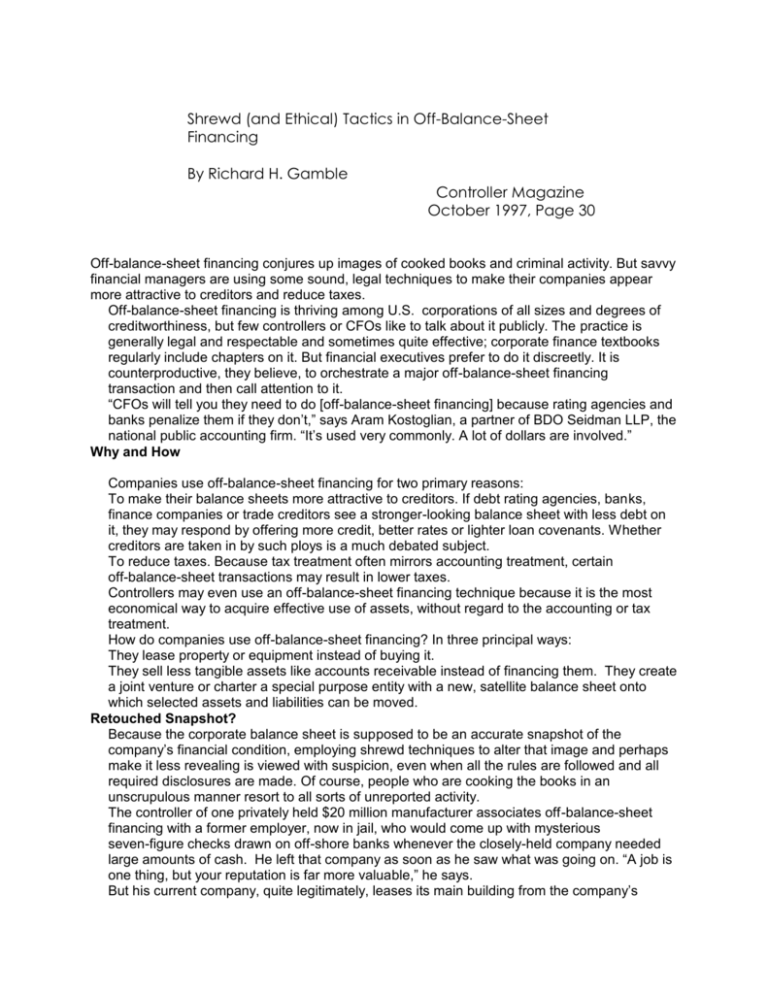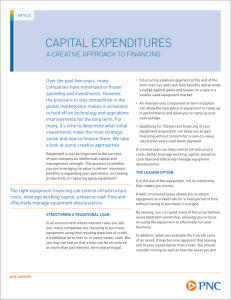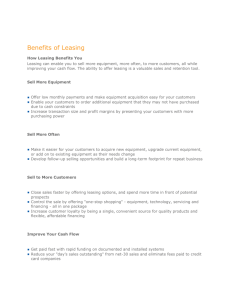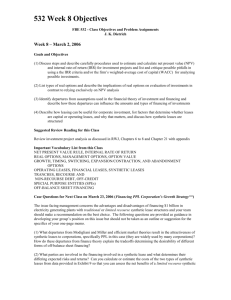Shrewd (and Ethical) Tactics in Off Balance Sheet
advertisement

Shrewd (and Ethical) Tactics in Off-Balance-Sheet Financing By Richard H. Gamble Controller Magazine October 1997, Page 30 Off-balance-sheet financing conjures up images of cooked books and criminal activity. But savvy financial managers are using some sound, legal techniques to make their companies appear more attractive to creditors and reduce taxes. Off-balance-sheet financing is thriving among U.S. corporations of all sizes and degrees of creditworthiness, but few controllers or CFOs like to talk about it publicly. The practice is generally legal and respectable and sometimes quite effective; corporate finance textbooks regularly include chapters on it. But financial executives prefer to do it discreetly. It is counterproductive, they believe, to orchestrate a major off-balance-sheet financing transaction and then call attention to it. “CFOs will tell you they need to do [off-balance-sheet financing] because rating agencies and banks penalize them if they don’t,” says Aram Kostoglian, a partner of BDO Seidman LLP, the national public accounting firm. “It’s used very commonly. A lot of dollars are involved.” Why and How Companies use off-balance-sheet financing for two primary reasons: To make their balance sheets more attractive to creditors. If debt rating agencies, banks, finance companies or trade creditors see a stronger-looking balance sheet with less debt on it, they may respond by offering more credit, better rates or lighter loan covenants. Whether creditors are taken in by such ploys is a much debated subject. To reduce taxes. Because tax treatment often mirrors accounting treatment, certain off-balance-sheet transactions may result in lower taxes. Controllers may even use an off-balance-sheet financing technique because it is the most economical way to acquire effective use of assets, without regard to the accounting or tax treatment. How do companies use off-balance-sheet financing? In three principal ways: They lease property or equipment instead of buying it. They sell less tangible assets like accounts receivable instead of financing them. They create a joint venture or charter a special purpose entity with a new, satellite balance sheet onto which selected assets and liabilities can be moved. Retouched Snapshot? Because the corporate balance sheet is supposed to be an accurate snapshot of the company’s financial condition, employing shrewd techniques to alter that image and perhaps make it less revealing is viewed with suspicion, even when all the rules are followed and all required disclosures are made. Of course, people who are cooking the books in an unscrupulous manner resort to all sorts of unreported activity. The controller of one privately held $20 million manufacturer associates off-balance-sheet financing with a former employer, now in jail, who would come up with mysterious seven-figure checks drawn on off-shore banks whenever the closely-held company needed large amounts of cash. He left that company as soon as he saw what was going on. “A job is one thing, but your reputation is far more valuable,” he says. But his current company, quite legitimately, leases its main building from the company’s owners, who own it outright. The owners get cash flow from the business through the rent payments; they also get to deduct depreciation of the building from their taxes. The corporate balance sheet shows only rent expense. The company benefits by having its balance sheet equity reduced. This particular company has stockpiled enough earnings that the controller worries about flunking the IRS accumulated earnings test and having to pay higher taxes because the company is not distributing more of its earnings as dividends. Keeping the building off the balance sheet helps, he says, by lowering the equity-to-debt ratio, one benchmark the IRS uses in its accumulated earnings test. Skeptical Creditors “Financial executives want to have their cake and eat it too — get the financing done without having the details quite so apparent,” observes Michael J. Flagg, now a consultant with Heidrick & Struggles Inc. in Chicago, but until recently a corporate CFO. The reward can be staying in compliance with leverage ratios included in debt covenants, he explains. “Some creditors make you put it back into the ratio calculations and some don’t.” Creditors and credit raters insist that they are not fooled by off-balance-sheet gimmicks. “Financial executives that use off-balance-sheet structures to outwit S&P or their bankers or insurers are fooling only themselves,” insists Amos N. Beason, assistant vice president of CoreStates Capital Markets, Philadelphia, who helps large multinationals set up off-balance-sheet financings. The real payoff from off-balance-sheet financing, he says, lies in “managing your tax position.” “You’re not really going to pull the wool over anyone’s eyes,” agrees Rich Thon, assistant treasurer of $6 billion ARAMARK Corp., a managed services company based in Philadelphia. “The rating agencies are clued into leasing. They look at the leasing obligations you disclose in your 10-K and apply their own formulas for calculating a kind of proxy debt, which they add back in. Many bank loan covenants include a fixed-charge coverage provision; both interest and lease payments count equally as fixed charges. So leasing doesn’t get you off the hook.” Accountant Kostoglian disagrees. “I don’t think banks can see through anything, although they always tell you they can,” he declares. Robert Barnhouse, the CFO and former controller of Baker Hi-Way Express, a privately-held $15 million Dover, Ohio trucking company, says that off-balance-sheet financing — primarily computer leasing — helps his company get its bank loan applications approved and qualify for better loan rates. Baker’s financial statements do not disclose its leasing, and the off-balance-sheet activity is “not caught by any of the questions we get asked by our banks. Sometimes banks do miss things,” he notes. Not surprisingly, banker Robert G. Brookby, executive vice president for Wachovia Bank of North Carolina NA, Winston-Salem, N.C., insists that his bank is not fooled. “We see all the information. Typically, if we are a lending bank, we have to approve the financing before they do it.” Lending banks scrutinize such financings case by case to see whether they strengthen or weaken the financial condition of the borrower, he explains. “Off-balance-sheet financing can be a plus for the company when it lowers its cost of capital and expands its sources of funding,” he observes. “It can also be a minus.” Selling receivables, he notes, “takes highly liquid assets out of the company. When that happens, we would expect to be told how the proceeds will be used. Unless the company is quite strong, we might think the proceeds should be used to reduce its loan or the loan commitment. It all depends on the structure and the financial condition of the borrower. For an asset securitization, we look closely at the level of recourse and the size of the reserves involved.” Leases are routinely factored into the way the bank computes debt and applies covenants, he says. Some multiple of the operating lease rent — typically six to eight times the monthly payment — is counted as the equivalent of balance sheet debt, he explains. Yet he concedes that including operating lease payments in covenants is spotty. Investment-grade companies rarely get their lease payments capped, while smaller companies are likely to have their leasing activity restricted by covenant. At Moody’s Investors Service in New York, all off-balance-sheet activity gets “factored into the debt rating process in the appropriate manner,” says Brad Gewehr, managing director for regional ratings in public finance. “We pay a great deal of attention to off-balance-sheet obligations. How much weight we give them depends on the circumstances — the nature of the obligation and how likely it is to be tripped.” Accounting rules often allow such obligations to be revealed in footnotes. “If we aren’t alert enough to pick it up, we could be misled, but that would be extremely rare,” Gewehr says. “Disclosure requirements today are stringent enough that off-balance-sheet obligations almost always surface.” Not all creditors are equally attentive to off-balance-sheet activity. The debt rating agencies won’t miss much. Neither will large, conservative bank lenders. Trade creditors are far less likely to look closely into off-balance-sheet financing. If you live with bank loan covenants and know how they are computed, you will know which off-balance-sheet ploys will help you keep your ratios in compliance. Pros and Cons of Leasing Leasing has grown into a huge market, and most common kinds of business property or equipment can now be leased. Computers, buildings, automobiles and aircraft are classic lease items, but you could equip a whole grocery store — shelving, coolers, carts and cash registers — with leased equipment, notes David J. Grand, business assurance partner in the Albany, N.Y., office of Coopers & Lybrand LLP. Companies usually lease because they don’t have the cash to make a large down payment or because they need property or equipment their loan covenants won’t let them buy with borrowed money, Grand explains. ARAMARK regularly performs lease-vs.-buy analyses and goes with the most economical alternative. “We’re usually better off leasing high-tech equipment because, at the end of the three-year lease period, it usually isn’t worth as much as the leasing company estimated,” Thon explains. When the economic cost of the two alternatives comes out equal, ARAMARK has a slight preference for leasing because “it doesn’t use up our bank credit lines under our revolver and gives us another source of credit,” Thon says. Accountants label leases as either operating leases or capital leases, Grand says, and the distinction is crucial because only operating leases qualify for off-balance-sheet treatment. Capital leases are given the same accounting treatment as balance sheet debt. If off-balance-sheet treatment is important to you, be sure your leases are set up so they will qualify as operating leases, Grand advises. Usually, if you pay for the full value of the equipment plus a financing charge over the term of the lease, it will be classified as capital and recognized as a variation of buying goods on a seller-financed installment plan, Grand says. Also, if the term of the lease exceeds 75 percent of the useful life of the leased item, the lease probably will be classified as capital. Tax Benefits Tax treatment also differs. Most tax-sensitive businesses prefer operating leases because they can write off the entire lease payment, Grand notes. With a capital lease, the asset has to be depreciated over its useful life, which typically is longer than the lease term. Leasing usually surfaces as a tax-driven strategy when the corporation needing the property or equipment cannot claim the depreciation deduction, either because it has no taxable income or because it is paying the alternative minimum tax (AMT). “Companies paying the alternative minimum tax often like to lease because they can’t deduct the full value of the depreciation on an asset they own, but they can claim the full cost of the lease as an operating expense,” explains CoreStates’ Beason. To finance expansion, Safeway Inc. of Oakland, Calif., sold its existing store properties to real estate trusts, then leased them back and used the proceeds to build new stores. The maneuver added no debt to Safeway’s balance sheet. There would be an additional tax benefit in years when Safeway might find itself paying the alternative minimum tax: Rather than lose the value of the depreciation deduction, it could continue to deduct the full cost of the leases, Beason points out. Securitization, Joint Ventures While leasing remains the most commonly used vehicle for off-balance-sheet financing, asset securitization is probably the fastest growing technique. Companies have been selling receivables to factors for years, typically at a fairly steep discount. The corporate balance sheet, in many cases, had little to do with getting the financing. Now asset securitization through multiseller conduits is bringing a whole new class of large, bankable credits to an off-balance-sheet financing vehicle that taps the capital markets efficiently and provides financing at rates and terms that are roughly equivalent to bank financing. Because the receivables are sold to special-purpose corporations (conduits) that pool trade receivables and use them to back commercial paper, the receivables are removed from the seller’s balance sheet, along with debt that would normally be used to finance them. There also are ways you can perform major surgery on your corporate balance sheet by creating a special-purpose entity (SPE) and choosing certain assets and liabilities to be transferred to the new SPE balance sheet. Accounting standards must be satisfied if you are to escape consolidated reporting, so get advice from qualified accountants before setting out on this course. One key criterion is that you not own controlling interest in the SPE, says accountant Kostoglian. Many joint ventures are structured so the venture gets its own balance sheet and none of the sponsoring companies own controlling interest and do not have to consolidate reporting like they would have to with a sub. Business Finance For the senior financial executive of one leveraged buyout company, off-balance-sheet financing is a matter of survival. It’s also a topic he cannot discuss unless he and his company remain anonymous. For him, off-balance-sheet financing is his only access to vital liquidity. “In a cyclical business, what are you supposed to do when you hit a cash crunch? You can’t borrow more money. That’s precluded by the covenants. You’re boxed in. So you look for any way you can to raise money through off-balance-sheet financing. You lease equipment rather than buy it. Or execute a sale lease-back of property.” Off-balance-sheet financing is a very technical area, more so for some types of financings than others, he has found. “You have to conform to the letter of the relevant FAS (financial accounting standard), so be sure to talk to your accountants first every time you do one. They could challenge your accounting treatment in their year-end audit, and you don't want that. It's better to get their ok up front," he warns. "Inventory, under FAS 49, is tough to get off-balance-sheet. Fixed assets means living within FAS 13.” His loan covenants limit the amount of debt his company can take on and count all sorts of contingent liabilities. But they do not restrict the company’s leasing activity, although some covenants do include rent payments in the fixed charge ratio. But off-balance-sheet financing is no panacea, even when it’s permitted and accounting standards are followed precisely, he says. Adding rent payments reduces your EBITDA (earnings before interest, taxes, depreciation and amortization), and that also can get you in trouble with your loan covenants, which, for an LBO, are closely tied to EBITDA. There is another problem with most operating leases, he notes: They end with a fair-market-value purchase option, which could force you to buy the item at a high price if its market value has risen sharply. One instrument to consider, he says, is the synthetic lease or off-balance-sheet loan. This instrument qualifies for off-balance-sheet accounting treatment but is treated by the IRS as a loan. You can fix the buyout price in advance with this instrument, but the lessee, not the lessor, gets the depreciation deduction, which makes it unappealing to an LBO that can’t use the deduction and would rather have lower lease payments. The LBO’s best choice, he says, is a standard lease with early buyout options that can protect the lessee from a steep run-up in the price. By layering an off-balance-sheet receivables securitization on top of bank financing, his company was able to reduce equity to almost zero, he says. “Nothing we’ve done is illegal or unethical. In fact, we’re quite proud of what we’ve been able to accomplish, but it’s a very sensitive area. I wouldn’t want my creditors to read about it. “If I were controller or treasurer of a new LBO, my first move would be to scour the balance sheet and put together an inventory of all the off-balance-sheet financing options available to me. I’d prepare a contingency plan based on those options so that I could pull the trigger quickly if a cash crunch came along,” he concludes.







